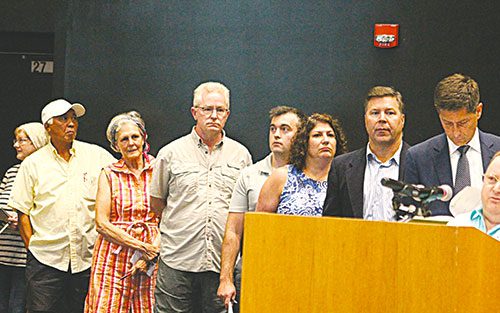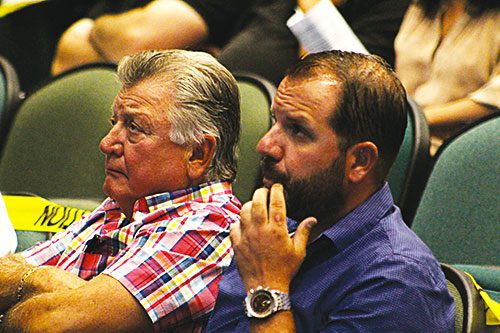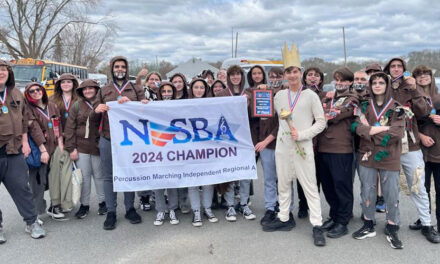Published August 15, 2019
By MAUREEN DOHERTY
NORTH READING —Eight months after a proposal first surfaced to build 200 apartments on portions of the former Thomson Country Club off Elm Street, the public hearing process before the Zoning Board of Appeals (ZBA) was opened last Thursday night, August 8.
This date is of importance when it comes to a Ch. 40B Comprehensive Permit because it starts the clock on the 180-day window for the board to open and close the public hearing process. Only a written extension from the applicant can extend the timeframe beyond the 180 days and once that public hearing is closed no new information can be accepted by the ZBA, which has 40 additional days to review the material, deliberate and present its written decision for a vote, which needs only a simple majority to approve or disapprove. This distinction is different from votes taken by this three-member board on other types of permits, which must be unanimous or they fail.
Beyond this, the timeline is now established for how and when appeals, if any, are made. The point is to expect this process to take up to six months plus up to 40 days for deliberations and another 20 days for any appeals to surface.

NEIGHBORS and townspeople who objected to the 40B application on a portion of the property formerly owned by the Thomson Country Club line up behind the podium to speak against it at Thursday’s ZBA public hearing. (Maureen Doherty Photo)
But as the more than 300 people who came to participate in this process at the NRHS Performing Arts Center learned, the August 8 start date serves another purpose under 40B — a community has 15 days from the date the hearing commences to potentially invoke another statute called “safe harbor.” In the case of 20 Elm St., the 15th day will be Friday, April 23.
For this reason, after nearly 3 1/2 hours of discussion divided between presentations by the applicant’s development team and testimony from at least a dozen people who spoke against the proposal, ZBA Vice Chairman James Demetri called for the meeting to be continued to tonight (Thursday, August 22) at 6:45 p.m. in the NRHS auditorium to discuss one agenda item — whether to invoke safe harbor.
The ZBA will have about 30 minutes to make this decision due to a scheduling conflict with two other public hearings that were already advertised to take place at Town Hall in Room 14 at 7:30 p.m. the same night. At about 7:15 p.m. the members will need to temporarily suspend their meeting at the high school and travel across town to hold those other two hearings. Room 14 only holds about 50 to 60 people comfortably, which is why the town decided first to use the high school’s Distance Learning Lab, which seats about 140, but ultimately moved it to the auditorium.

NICK YEBBA (left) listens to a member of his team present his 40B proposal for 20 Elm St. (Maureen Doherty Photo)
Why safe harbor?
What could cause a town to invoke the safe harbor claim?
According to Dan Hill, an attorney hired by the members of Defend Ipswich River Communities (DIRC), a private group based in North Reading opposed to this development, there is more than one way the town can meet its obligation of providing an adequate number of housing units deemed by the state to be within the financial reach of those whose incomes fall within the low to moderate range based on the scale of median income in the region.
The most common calculation referenced under 40B is that 10% of the housing stock must meet the affordability threshold. If it does, the town is not forced to accept a 40B application and can in theory seek out the development of such housing in a more friendly way with developers; for example, through a Housing Production Plan developed with the help of a state grant, such as North Reading had done a few months prior to NY Ventures submitting its plans for 20 Elm St. last December when the town’s percentage stood at 9.6% or 20 units shy of the threshold.
The addition of 200 apartment units would add 25 below-market rate rental units to the town’s housing stock, plus as an incentive for developers to build dense housing in the suburbs, the state allows towns to count 100% of rental units built under a 40B permit toward the affordability threshold.
So what about this safe harbor clause Hill mentioned? “This would be a 200-unit project so obviously 10 times the units you actually need. But there is also a second threshold; it is called the ‘land area threshold,’ … if a town has affordable housing on at least 1.5% of its total land area then that serves the same purpose,” Hill said.
But the town will have a hurdle to overcome in calculating the actual amount of acreage taken up by several group homes operating in residential neighborhoods. “There are 51 bedrooms or units that are managed by the state Department of Developmental Services,” he said.
“And this department keeps an inventory of all the group home units in every town in the state, but it’s secret. They don’t tell anybody where these units are because that’s deemed to be an infringement upon the privacy of the individuals being served. So no one really knows for sure where these group homes are; maybe some people do, but there are no official records, except for the records that are kept by the state DMR,” Hill told the board.
Hill said he is aware that the town is consulting with its GIS department to run calculations that could help determine if the 1.5% land area has been reached. He said 51 units “could be a substantial. Group homes typically have eight beds and they look like single-family homes. So if you were to picture six or seven of these group homes around town, that could easily be five to 10 acres.”
“If you don’t assert the defense within 15 days, you’ll lose it and you can never assert it again,” Hill explained.
Demetri to lead this 40B process
At the outset of the meeting, Vice Chairman James Demetri stated that he would be chairing the proceedings for this entire 40B process. Joining him on the panel are members Joseph Keyes and Jennifer Platt and associate members Matt DeAngelo and Bill Bellavance. Since only three members are needed for voting purposes, DeAngelo and Bellavance would only vote if another member was unable able to do so, but they have to attend the meetings just as the regular members would. Chairman Paul O’Leary will not be participating in these hearings.
Also present to advise the board to serve as Town Counsel was Amy Kwesell of KP Law,
Members of the development team representing Nick Yebba of NY Ventures at the first meeting were attorney Ted Regnante, engineer Chris Sparages and architect David O’Sullivan. After nearly 90 minutes of their technical overview, Demetri cut the presentations short to allow those present to comment and ask questions. Their detailed PowerPoint presentation is posted on the town’s website (www.northreadingma.gov) which will be reviewed in depth in a future story.
The 200-units would consist of 50% one-bedroom units (100 total) in four layout configurations, 40 percent two-bedroom units (80 total) in three layout configurations, and 10 percent three-bedroom units (20 total) in two layout configurations.
O’Sullivan said the five identical buildings would be 57 feet high with four residential floors situated on top of a podium to accommodate parking, each accessed by a garage door. Traffic would flow off a 600-foot long driveway off the current access point at Elm Street with sidewalks constructed on either side. Sparages explained that the traffic flow was designed to minimize circulation within the internal driveways leading to each building’s surface parking lots and parking garages.
Public comment
Audience members then lined up at the podium to speak for over 90 minutes.
“I am one of the closest abutting people to this fiasco that is being perpetrated on us,” Christine MacNeil of 4 Lynn St., said, who added that two of the five buildings will “tower over not only my home but the rest of the homes in that neighborhood. They will literally cast a shadow over me. One of the proposed buildings is about 50 feet from the back wall of my house. Not my property line — the back wall of my house! That’s a big deal; it should be a big deal for anybody to have a building that big, that close.”
Due to the topography, MacNeil said her house is situated in a “depression” which will give the illusion that she is looking up at a seven-story building. “I have nothing to do with the image on the Defend Ipswich River sign, but that big building hanging over that little house, that is my house,” she said. She invited the ZBA members to her house so that they can “see the flags that have been put up and then imagine a five-story building on top of that.”
MacNeil, who has lived her for 21 years, also has grave concerns about the applicant’s proposal to handle stormwater on-site and the loss of habitat for the wildlife that currently use this land as a chute to access the river and its banks.
“This is a very wet area of town and we’re at very severe risk; I don’t want a swimming pool in my basement. This will drastically change the natural drainage and runoff that occurs in that area; there’s nothing they can do that wouldn’t change it.”
“I hoped you would really listen and I was serious when I invited you into my backyard,” MacNeil said. “Please see the flags that have been put up and then imagine a five-story building on top of that.”
Demetri said they might take her up on that offer.
Tom Woo, 40 Riverside Dr. and a 35-year resident of the neighborhood, refuted the claim by the applicant’s engineer that 20 Elm Street is within walking distance of stores.
“There’s no sidewalks back there; the closest variety store and grocery store are two miles away; you have to have a car. The closest store is Christopher’s; it’s two miles away. Big Y is two miles away (in West Peabody). He said (the site is) within walking distance of stores; it is not.”
Woo added that he recently came upon an accident in this area of Rte. 62 and recalled that there had been a fatal accident in this neighborhood about five years ago. All residents of the apartment complex would need to cross Elm Street to access the sidewalk at the same point where 300-plus new cars would be accessing the road.
This sidewalk ends at the Middleton line to the east and travels west about two miles to the town center. “We had a fatality there roughly less than five to seven years ago. The traffic there is going to be unbearable. We don’t need this here,” Woo said.
He also said they had defeated a proposal about 20 years ago to place 16 units of Section 8 housing on Lynn Street.
Patricia Campbell of Lynnfield attended the meeting as a concerned downstream neighbor of the Ipswich River. “I’m a member of the Lynnfield Center Water District (LCWD). Lynnfield is one of 14 communities that get drinking water from the Ipswich River. These are my concerns about a conditions of approval with the massing of housing: 200 units instead of 10 homes? Those units will likely have at least 400 bathrooms, next to a wetland and next to an endangered river from which many residents of Lynnfield, including myself, get their drinking water.
It appears that the land slopes toward the river. This development is detrimental for that reason. It’s also detrimental because these apartment buildings generate a lot of traffic, not only in your town, but in my town. Also in Reading, Middleton and Peabody. Our Town Meeting has defeated two proposals for dense housing near the Sagamore Golf Course,” Campbell said. This news drew applause from the audience.
Campbell responded: “I’m very proud of it. Some very concerned people, like yourselves, showed up at the ConCom meetings, at the Planning Board, at the Finance Committee. Keep it up because that is very important.”
Drinking water quality
“The applicant states the development would generate over 35,000 gallons of water daily. That is roughly 13 million gallons a year. Every year. What does that amount of wastewater, treated onsite and discharged into our groundwater invisibly without any form of monitoring or testing mean for the lowest flow river in Massachusetts?” abutter Elizabeth Coolidge-Stolz, 2 Gillis Dr., asked in her statement to the board.
Not waiting for their response, she continued: “It means that every day the ground absorbs water that is not carried away for treatment but stays here on a small parcel originally almost entirely wetlands that runs downhill to the neck of a vulnerable, low flow river that supplies over a third of a million people.”
“And this is how much it will matter to the Ipswich, one of the most endangered rivers in our country: If we stood on the Middleton bridge today and it carried the average daily flow for the last 81 years — as shown online by the U.S. Geological Service — we could draw a glass of water. If the development were there, and its daily wastewater was represented in proportion in the river – no more, no less, but just right – 0.8% of the glass we pulled from the river would represent water that had just entered the Ipswich from 20 Elm Street,” Coolidge-Stolz stated.
“You would hold a glass of water where almost one part of 100 came from the leach field of the septic system for the 200 apartments, parking lot, roadways, and runoff from Route 62 that drain down onto and into 20 Elm Street. I am not asking you to act without thinking. I ask the opposite. I ask you to read, to deliberate, and to think a lot… and then to act. This is a decision you will make once, but will affect all of us, and potentially forever,” she concluded.




